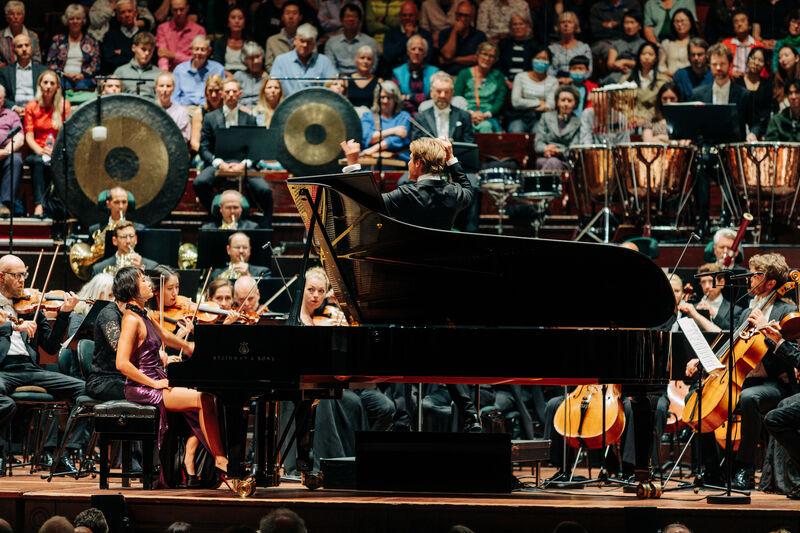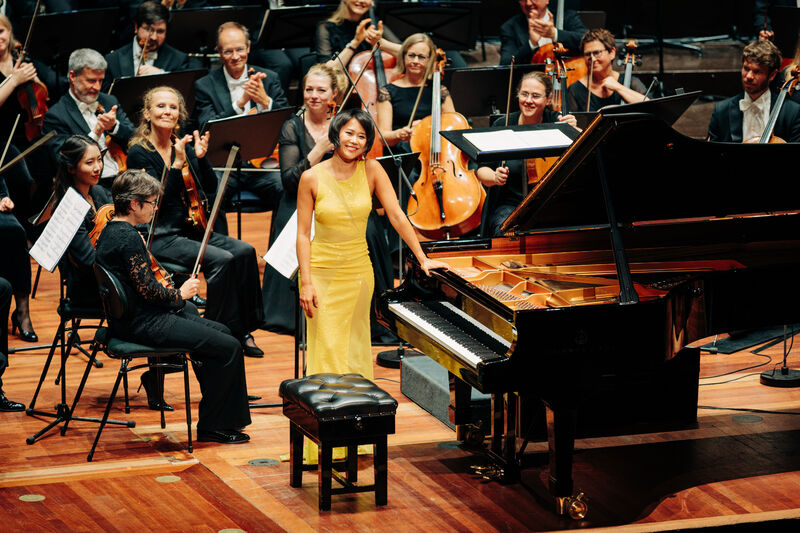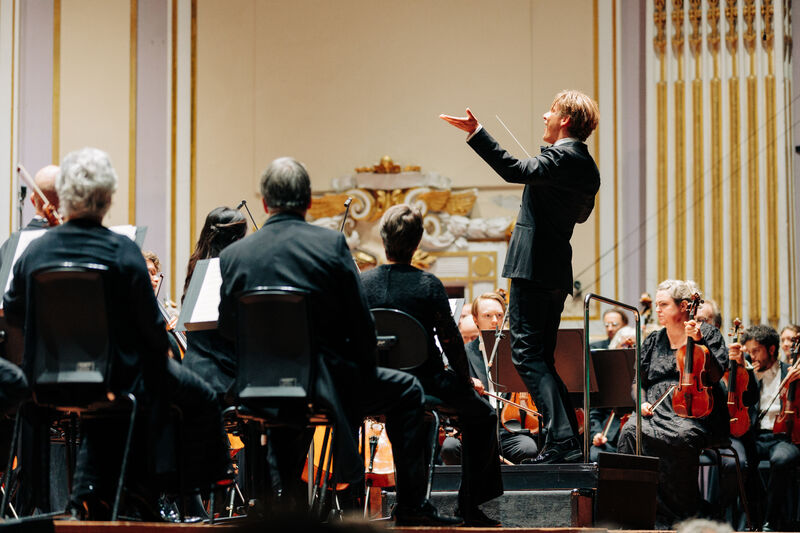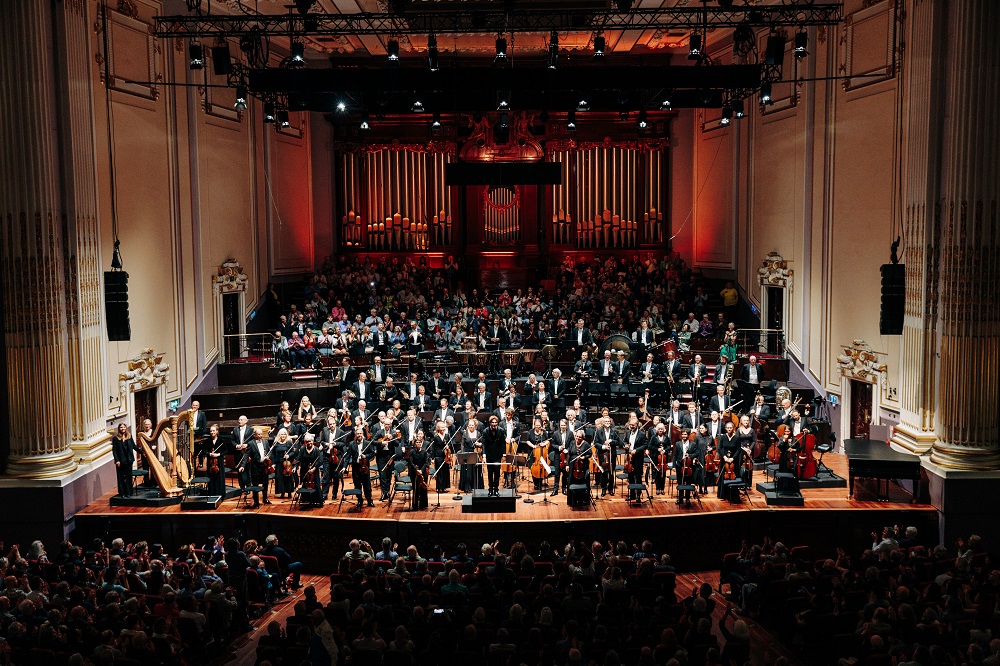Wang, Oslo Philharmonic, Mäkelä, Edinburgh International Festival 2023 review - sparkling concertos, bleak Shostakovich | reviews, news & interviews
Wang, Oslo Philharmonic, Mäkelä, Edinburgh International Festival 2023 review - sparkling concertos, bleak Shostakovich
Wang, Oslo Philharmonic, Mäkelä, Edinburgh International Festival 2023 review - sparkling concertos, bleak Shostakovich
Power sometimes over-urged, but this was quite a programme

Every time I have heard Ravel’s Piano Concerto for the Left Hand, some wiseacre in the bar afterwards trots out the predictable joke that it’s a cheap concert as the pianist gets only half the fee. For all that this is obviously nonsense, most pianists go on to play a two-handed encore to set the record straight. Yuja Wang, in her Edinburgh Festival concert with the Oslo Philharmonic Orchestra, chose to play a whole other piano concerto, in this case the same composer's G major.
The two concertos required a change of costume for our flamboyant soloist, from shimmering purple to sunset yellow (pictured below), but the similarities between the concertos are greater than the differences. Both inhabit a similar, jazz-imbued universe, and require near-chamber forces, even if the Left Hand Concerto is more heavily weighted, at times grandiose, by contrast with the gossamer lightness of the G major. The programme note helpfully points out that there are in fact more notes in the Left-Hand Concerto.  There was much zest and glitter to enjoy in both these performances, but I’m not sure how much pillow talk the Oslo Philharmonic’s young Chief Conductor Klaus Mäkelä had devoted to discussing with Wang their joint approach to tempi and dynamics for the two concertos. He seemed inclined to crack on at pace, particularly in the Left-Hand Concerto, whereas she tended to put the brakes on. It seemed a bit edgy, but maybe there are risks you can take when you know your soloist really well. Her playing is a delight, wonderfully light and fluid, particularly in the second cadenza, but when orchestra and soloist were playing together I found the former a shade too loud, even with minimal instrumentation. There’s nothing like an exception to prove the rule, however, so special mention for Min Hua Chiu’s exquisitely judged cor anglais solo in the second movement of the G major Concerto.
There was much zest and glitter to enjoy in both these performances, but I’m not sure how much pillow talk the Oslo Philharmonic’s young Chief Conductor Klaus Mäkelä had devoted to discussing with Wang their joint approach to tempi and dynamics for the two concertos. He seemed inclined to crack on at pace, particularly in the Left-Hand Concerto, whereas she tended to put the brakes on. It seemed a bit edgy, but maybe there are risks you can take when you know your soloist really well. Her playing is a delight, wonderfully light and fluid, particularly in the second cadenza, but when orchestra and soloist were playing together I found the former a shade too loud, even with minimal instrumentation. There’s nothing like an exception to prove the rule, however, so special mention for Min Hua Chiu’s exquisitely judged cor anglais solo in the second movement of the G major Concerto.
The audience responded with enthusiastic applause, as well they might, for this double bill from a superstar pianist, but despite dragging her back on stage several times she couldn’t be persuaded to an encore – “well, she has just played two concertos,” said the man next to me.  After the interval we saw a much larger orchestra pushing at the limits of the Usher Hall stage for a performance of Shostakovich’s evergreen Fifth Symphony. This is arguably the easiest of Shostakovich’s symphonies to listen to, but it is not necessarily the easiest to understand. Its famous attribution as “a Soviet artist’s response to just criticism” makes it easy to pigeonhole as a compliant work designed to curry favour with the authorities. But that very much depends on the performance, and in Mäkelä’s meticulous interpretation, I believe we saw something entirely different.
After the interval we saw a much larger orchestra pushing at the limits of the Usher Hall stage for a performance of Shostakovich’s evergreen Fifth Symphony. This is arguably the easiest of Shostakovich’s symphonies to listen to, but it is not necessarily the easiest to understand. Its famous attribution as “a Soviet artist’s response to just criticism” makes it easy to pigeonhole as a compliant work designed to curry favour with the authorities. But that very much depends on the performance, and in Mäkelä’s meticulous interpretation, I believe we saw something entirely different.
In the justly famous Largo, a slow movement that apparently moved the audience at its premiere to tears, there was no consolation. Mäkelä’s tuttis expressed either solemn resignation or the great cry of anguish of a people repressed. The haunting solos for flute, oboe, and clarinet are individual voices from the crowd, but felt as though suspended by a thread over the quietest, most tentative of string tremolandos (where was this control in the Ravel?).  The scurry and flurry of the scherzo had a nightmare quality, as though we had gone to the park to have a nice time but round every corner there’s a bandstand with musicians hacking out the same gruesome music. In the two outer movements Mäkelä once again focused on the voice of the individual in the crowd, drawing out the precarious and exposed solos the better to express their vulnerability. Both movements have degree of martial pomp, but in this interpretation the tub thumping brashness was rendered as a cynical afterthought by the poignancy of what had preceded it.
The scurry and flurry of the scherzo had a nightmare quality, as though we had gone to the park to have a nice time but round every corner there’s a bandstand with musicians hacking out the same gruesome music. In the two outer movements Mäkelä once again focused on the voice of the individual in the crowd, drawing out the precarious and exposed solos the better to express their vulnerability. Both movements have degree of martial pomp, but in this interpretation the tub thumping brashness was rendered as a cynical afterthought by the poignancy of what had preceded it.
Conducting without a score, Mäkelä conjured an impressive and revelatory performance of a symphony of pivotal importance in the history of 20th century music. It would be nice to think that even over a gap of almost a century there should be a degree of empathy between a charismatic conductor already launched on a glittering international career and a similarly young composer putting notes on a stave not only to rebuild his reputation but to save his life.
rating
Explore topics
Share this article
The future of Arts Journalism
You can stop theartsdesk.com closing!
We urgently need financing to survive. Our fundraising drive has thus far raised £49,000 but we need to reach £100,000 or we will be forced to close. Please contribute here: https://gofund.me/c3f6033d
And if you can forward this information to anyone who might assist, we’d be grateful.

Subscribe to theartsdesk.com
Thank you for continuing to read our work on theartsdesk.com. For unlimited access to every article in its entirety, including our archive of more than 15,000 pieces, we're asking for £5 per month or £40 per year. We feel it's a very good deal, and hope you do too.
To take a subscription now simply click here.
And if you're looking for that extra gift for a friend or family member, why not treat them to a theartsdesk.com gift subscription?
more Classical music
 Hallé John Adams festival, Bridgewater Hall / RNCM, Manchester review - standing ovations for today's music
From 1980 to 2025 with the West Coast’s pied piper and his eager following
Hallé John Adams festival, Bridgewater Hall / RNCM, Manchester review - standing ovations for today's music
From 1980 to 2025 with the West Coast’s pied piper and his eager following
 Kaploukhii, Greenwich Chamber Orchestra, Cutts, St James's Piccadilly review - promising young pianist
A robust and assertive Beethoven concerto suggests a player to follow
Kaploukhii, Greenwich Chamber Orchestra, Cutts, St James's Piccadilly review - promising young pianist
A robust and assertive Beethoven concerto suggests a player to follow
 Robin Holloway: Music's Odyssey review - lessons in composition
Broad and idiosyncratic survey of classical music is insightful but slightly indigestible
Robin Holloway: Music's Odyssey review - lessons in composition
Broad and idiosyncratic survey of classical music is insightful but slightly indigestible
 Classical CDs: Wolf-pelts, clowns and social realism
British ballet scores, 19th century cello works and contemporary piano etudes
Classical CDs: Wolf-pelts, clowns and social realism
British ballet scores, 19th century cello works and contemporary piano etudes
 Bizet in 150th anniversary year: rich and rare French offerings from Palazzetto Bru Zane
Specialists in French romantic music unveil a treasure trove both live and on disc
Bizet in 150th anniversary year: rich and rare French offerings from Palazzetto Bru Zane
Specialists in French romantic music unveil a treasure trove both live and on disc
 Scottish Chamber Orchestra, Ibragimova, Queen’s Hall, Edinburgh review - rarities, novelties and drumrolls
A pity the SCO didn't pick a better showcase for a shining guest artist
Scottish Chamber Orchestra, Ibragimova, Queen’s Hall, Edinburgh review - rarities, novelties and drumrolls
A pity the SCO didn't pick a better showcase for a shining guest artist
 Kilsby, Parkes, Sinfonia of London, Wilson, Barbican review - string things zing and sing in expert hands
British masterpieces for strings plus other-worldly tenor and horn - and a muscular rarity
Kilsby, Parkes, Sinfonia of London, Wilson, Barbican review - string things zing and sing in expert hands
British masterpieces for strings plus other-worldly tenor and horn - and a muscular rarity
 From Historical to Hip-Hop, Classically Black Music Festival, Kings Place review - a cluster of impressive stars for the future
From quasi-Mozartian elegance to the gritty humour of a kitchen inspection
From Historical to Hip-Hop, Classically Black Music Festival, Kings Place review - a cluster of impressive stars for the future
From quasi-Mozartian elegance to the gritty humour of a kitchen inspection
 Shibe, LSO, Adès, Barbican review - gaudy and glorious new music alongside serene Sibelius
Adès’s passion makes persuasive case for the music he loves, both new and old
Shibe, LSO, Adès, Barbican review - gaudy and glorious new music alongside serene Sibelius
Adès’s passion makes persuasive case for the music he loves, both new and old
 Anja Mittermüller, Richard Fu, Wigmore Hall review - a glorious hall debut
The Austrian mezzo shines - at the age of 22
Anja Mittermüller, Richard Fu, Wigmore Hall review - a glorious hall debut
The Austrian mezzo shines - at the age of 22
 First Person: clarinettist Oliver Pashley on the new horizons of The Hermes Experiment's latest album
Compositions by members of this unusual quartet feature for the first time
First Person: clarinettist Oliver Pashley on the new horizons of The Hermes Experiment's latest album
Compositions by members of this unusual quartet feature for the first time

Add comment